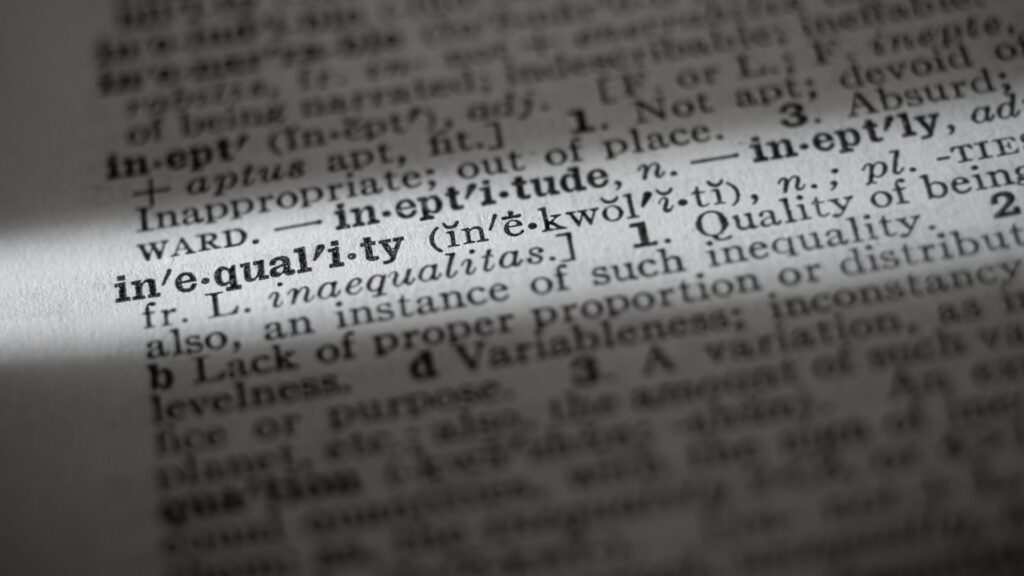BACK TO RESEARCH WITH IMPACT: FNR HIGHLIGHTS
As the FNR marks 25 years since its creation, we highlight 25 examples of FNR-supported research with impact.
Since arriving in Luxembourg in 2001, Philippe Van Kerm has led various projects studying the dynamics of social inequalities, developing measurement tools to shed light on the drivers of distributional change.

Socio-economic inequalities are often described as a defining challenge of our time. Ever since the turn of the century, there has been a growing in interest among academics, the public, and policy makers alike to understand the potential negative consequences of excessive concentration of economic resources. The field of social inequalities has become important in both economics and sociology. Developments in the possibilities to gather and analyse data on a large scale, in areas such as income, wealth and living conditions has been of significant benefit for the field.
“Understanding and addressing socio-economic inequality is not only an academic exercise, it is now considered central to building inclusive, democratic societies,” explains Philippe Van Kerm, Professor of Social Inequality and Social Policy at the University of Luxembourg, and previously at the Luxembourg Institute of Socio-Economic Research (LISER).
Van Kerm & team study the dynamics and determinants of various forms of socio-economic inequalities, with a focus on high-income countries.
“I develop measurement tools and apply those to large-scale datasets to study diverse drivers of distributional change – looking, e.g., at the impact of assortative mating and union formation, intergenerational transfers, industrial robots in the workplace, educational expansion, or policy change such as the minimum wage. ”Philippe Van Kerm Professor of Social Inequality and Social Policy at the University of Luxembourg
Multi-layered research with impact
Van Kerm considers the broadest impact of the team’s work to be raising awareness about the level and trends in important social indicators. These include poverty rates, measures of economic inequality, but also indicators of social diversity in schools.
“Providing careful, methodologically-robust and objective diagnostics is a first step before even considering the necessity of intervention.”
A second layer of impact is the provision of knowledge and tools that make it possible study the determinants of these social indicators.
“Understanding their main drivers – over time or across societies – can help think of potential interventions, e.g., are changes mainly driven by demographic factors, or by labour market evolutions, or by tax-benefit or other policy parameters.”
Van Kerm explains that a better understanding of the potential impact of specific interventions, whether it is learning from past interventions or projecting hypothetical future decisions, is essential in guiding good policy decisions.

“Thirdly, and very concretely, we have developed in the course of our research, various software tools that are widely used by analysts world-wide not only in academia, but also by statistical institutes and by policy advisors who conduct empirical analysis of social indicators, income and wealth distribution. Providing such software solutions has facilitated the transfer of knowledge and the implementation of methods outside academic circles. ”Philippe Van Kerm Professor of Social Inequality and Social Policy at the University of Luxembourg

Methods for a clearer look at impact of specific dynamics
Van Kerm considers the main contributions of him and his team’s research to be the development of statistical methods that enable the study of distributions of outcomes, as well as the dynamics of these outcomes.
“Most tools in data scientists’ toolboxes are designed to assess impacts ‘on the mean’ of outcomes of interest. But studying inequality obviously requires tools that to go beyond examining “averages” towards examining broader “distributive” impacts – we need to assess effects ‘at the bottom’, ‘in the middle’ and ‘at the top’ and understand how these combine to shape inequality.”
As an example, Van Kerm and team worked on developing and refining “influence function regression methods” – methods easy to implement which have found widespread use. The methods have recently provided insight into not just whether inheritances increase wealth, but whether and how much inheritances increase inequality in wealth.
They have also helped to understand not just whether foreign workers increase average earnings but whether they tend to increase overall earnings inequality.
Income growth profiles & a method to understand drivers of means, inequality and poverty
Another highlight of the team is the development of what Van Kerm refers to as “distribution regression models”: Similar to regression models, but with the added benefits of allowing models for entire distributions. It makes it possible to jointly examine drivers of means, inequality, and poverty.
Furthermore, in an FNR-funded project, the team created income growth profiles, an approach that aims to quantify the notion of inclusive growth and has attracted a large number of users.

“We proposed an intuitive concept of growth that attaches greater importance to ‘low income’ people and developed flexible regression-based methods to visualise these patterns and robustly test for changes over time. We showed that there are relatively large year-on-year income gains (and losses) in European countries and that these are progressive everywhere we looked – that is, they are on average larger (in relative terms) the lower is the starting position. It is the net effect of many simultaneous gains and losses that has led to a gradual increase in income inequality that we have observed in a number of countries over the recent two decades. ”Philippe Van Kerm Professor of Social Inequality and Social Policy at the University of Luxembourg

Examining trends over time to identify what works
Once it has been established how to measure inequalities, the next step is to examine trends over time in order to make comparisons across societies.
“The goal is to try and identify what are key micro-determinants – arising from individual decisions and circumstances – as well as macro-determinants, which arise from global trends such as technological change, demographic trends, social and economic policies, etc. This is key knowledge to think of potential interventions.”
Van Kerm’s main future research goals are identifying “what works” in terms of reducing poverty, mitigating inequality and fostering prosperity, which he will approach by rigorously assessing the implications of interventions and policy decisions and evaluating the impacts of major socio-economic shocks.
But – getting a clear picture of social inequality and its many drivers is nowhere near simple, and Van Kerm explains many challenges lie ahead. For example, despite all the research already conducted, a key question remains: What are the precise drivers of long-term levels and trends in inequality in contemporary societies? The challenge in answering this question stems from the fact that it has multiple layers and it is in constant evolution.
“I often describe research on the determinants of inequality as looking at matriochkas – it has multiple layers. On the outside we have determinants related to human capital and education, to the labour market, to social insurance mechanisms. These are extensively researched and I would say we have a good understanding of their roles in determining inequality. That being said, these factors are also in constant evolution – think of how globalization, technological change and institutional changes have impacted employment or Welfare State institutions: their relative importance over time and across contexts remains a matter of debate and we can expect that, for example, the rise of artificial intelligence and “intelligent robots” on the labour market will pose new challenges to social welfare. ”Philippe Van Kerm Professor of Social Inequality and Social Policy at the University of Luxembourg
Challenge to untangle impact of deeper layers that reach down to historical and geographical factors
Van Kerm explains there are also deeper layers, relating to what drives the emergence of specific Welfare State institutions, or specific of economic structures and development. These layers are much more challenging to research – little is known about how exactly they have shaped inequalities in contemporary societies. They have deep and varied roots, from historical and geographical factors, to attitudes and social norms, but also in the political institutions that decide how societies are organised.


Unravelling the effects of policies and economic shocks
Another challenge is identifying the causal effects of policies or economic shocks on inequality and the distribution of welfare in a broader way.
“Obviously, one cannot resort to the classic experimental designs since potential determinants of social inequalities cannot be randomised. Furthermore, we are looking at factors which are broad – they rarely hit well-defined populations in isolation – and slow-moving – their effects build up over time. Natural experiments may sometimes come to the rescue and artificial intelligence-based tools may potentially help in the future for simulation-based approaches, but whether they will be able to provide definite, universal answers some of the big questions about inequality drivers remains uncertain.”
What is the relationship between inequality and politics?
The relationship between objective, perceptions of inequality, and politics is also a tricky endeavour. Van Kerm explains that perceptions of inequality are often not at all what analysts consider objective measures of inequality: These perceptions can be fuelled by populist political discourses, with implications for political outcomes, and subsequent policy decisions that will influence social outcomes and socio-economic inequalities.
“Better understanding the formation of perceptions of social inequality and their connection to future policy outcomes is important and remains challenging. This might be key to address the political challenges to effective redistribution and social protection in an era of rising populism and institutional mistrust.”


How the field will evolve: Data, data, data
Van Kerm explains that large-scale administrative are increasingly being made available for research, equipping them with valuable data that enables the tracking of trajectories across key phases of people’s lives: early childhood, school, work. This gives researchers the chance to study the dynamics of individual welfare over time.
“Broader access to large matched administrative records and surveys will challenge how we assess welfare in a long-run perspective; how we assess long-run inequality and how we assess policy interventions. This will feed both more theoretical and empirical work.”
Advancements in technical tools are also revolutionising the possibilities of inequality research:
“Machine learning methods are now used in the field – for example to predict socio-economic outcomes from past events, circumstances or life courses; or to handle missing data issues, or help in matching data from disjoint sources. Machine learning and artificial intelligence tools will certainly be leveraged further in research.
“I can see them being used to augment information available in existing data – by helping to match sources, by generating or imputing missing information, by helping simulating counterfactual societies under alternative scenarios.”
Impact of FNR on Van Kerm & team’s research
“A few years ago, I benefited from an INTER Mobility OUT to spend a year at the London School of Economics and Political Science – perhaps the best social science university in Europe. Collaborations I developed there have had impacts on projects for many years after the visit. Again, it is probably not so much the work actually completed during the visit that mattered but the longer term collaborations and multiple projects that were later initiated thanks for connections established during the visit.”
“In my experience, funding from the FNR has been especially important to transition from junior to established researcher status. Research funding has allowed me to develop independent projects and bring young researchers to work with me on various projects.
Importantly, the impact of FNR funding goes well beyond specific projects or project durations. Many projects that I am currently working on emanate from research ideas and collaborations that were initiated in the context of specific projects funded by the FNR potentially years ago.
Funding for doctoral researchers that have come and worked with me over the last 15 years or so has been particularly important – via BFR, AFR or PRIDE funding schemes.”
Van Kerm on mentoring the next generation
“I would say about 20-25 young researchers have been working with me in FNR-funded projects – counting researchers funded by dedicated funding schemes for doctoral researchers. The majority of them have pursued research careers but some have also moved to think tanks or policy research institutions.
Mentoring young researchers is mutually enriching. It is always stimulating to work together on projects and methods and data. Discussions with supervisees often give rise to new ideas. In turn, I do hope supervisees learn something valuable from working with me!”
Philippe Van Kerm’s FNR-funded projects (main applicant)
| Project title | Call year | FNR funding instrument |
| Smartwielen: Use and impact at the 2023 national and 2024 European elections | 2022 | INTER Mobility |
| The impact of childhood circumstances on individual outcomes over the life-course | 2016 | INTER |
| Tax-benefit systems, employment structures and cross-country differences in income inequality in Europe: a micro-simulation approach | 2013 | CORE |
| Inequality research at the London School of Economics and Political Sciences | 2012 | INTER Mobility |
| Information and wage inequality: Evidence on wage differences between natives, immigrants and cross-border workers in Luxembourg | 2010 | CORE |
| Advances in the Measurement of Discrimination, Inequality and Mobility | 2005 | VIVRE (former funding instrument) |
Related Funding Instruments
Related highlights
25 examples of research with impact: Driving innovation in software engineering, security, and AI
As the FNR marks 25 years since its creation, we highlight 25 examples of FNR-supported research with impact. Since arriving…
Read more
25 examples of research with impact: A solid foundation for artificial intelligence
As the FNR marks 25 years since its creation, we highlight 25 examples of FNR-supported research with impact. Artificial intelligence…
Read more
25 examples of research with impact: Smart materials for a sustainable future
As the FNR marks 25 years since its creation, we highlight 25 examples of FNR-supported research with impact. Since arriving…
Read more
25 examples of research with impact: Advancing AI and Computer Vision: From space tech to better healthcare
As the FNR marks 25 years since its creation, we highlight 25 examples of FNR-supported research with impact. Since arriving…
Read more
25 examples of research with impact: Understanding the evolution of the workplace in the digital era
As the FNR marks 25 years since its creation, we highlight 25 examples of FNR-supported research with impact. Active in…
Read more
25 examples of research with impact: Breaking barriers in cancer research & treatment
As the FNR marks 25 years since its creation, we highlight 25 examples of FNR-supported research with impact. In Luxembourg…
Read more